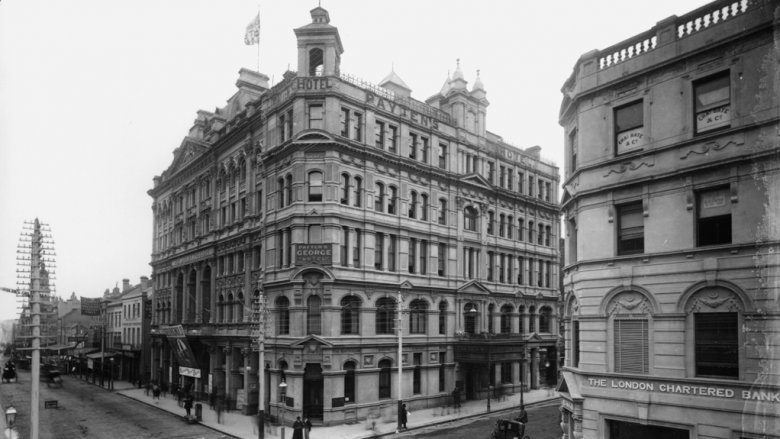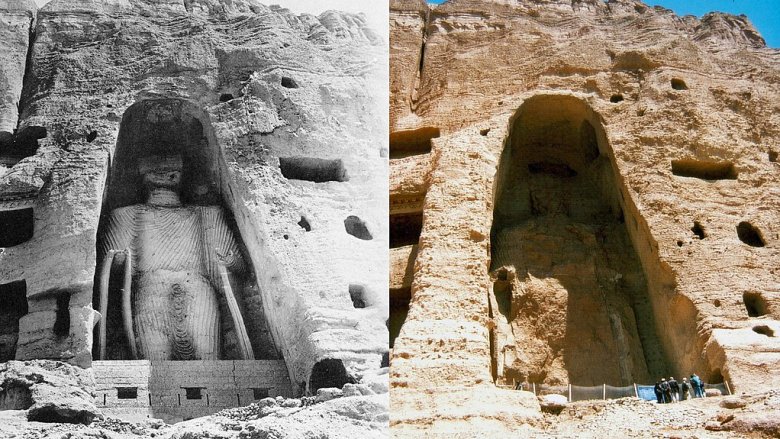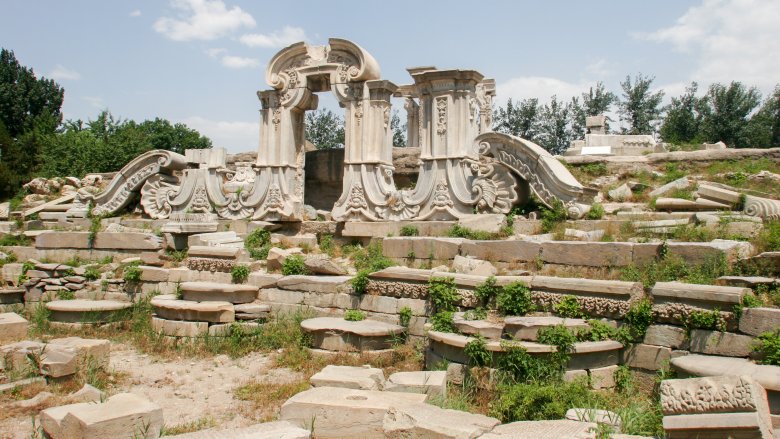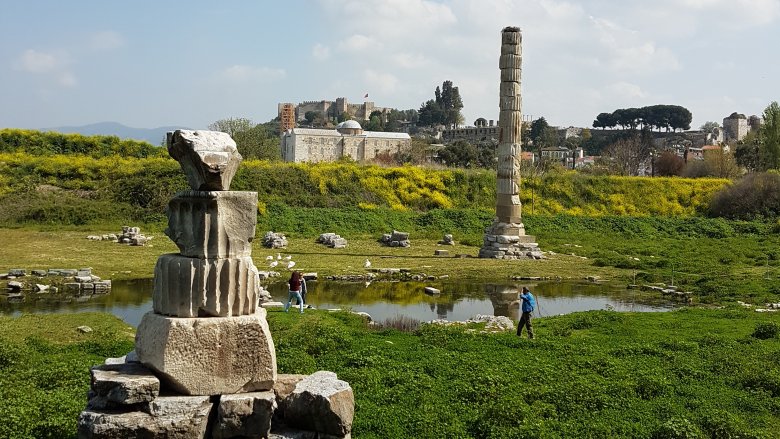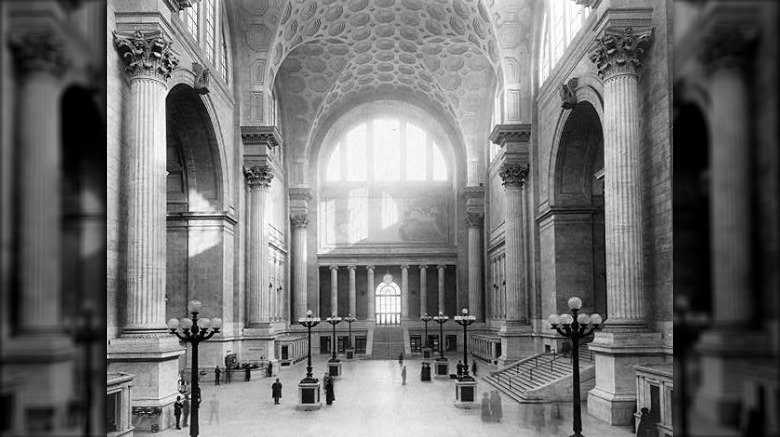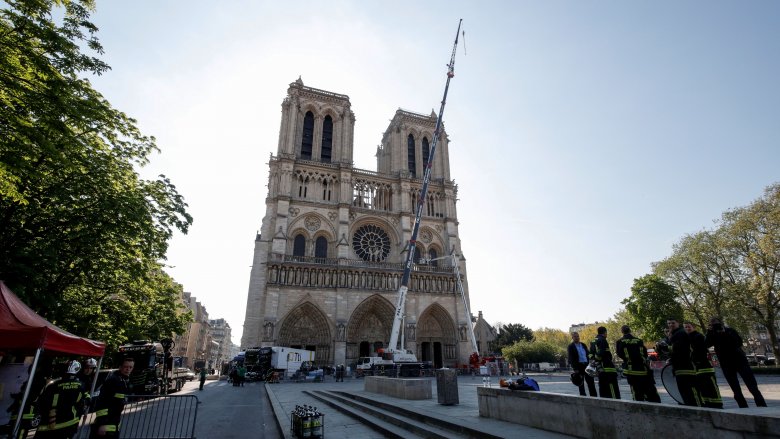World Landmarks That Have Been Lost To History
We live in a world of earthquakes, war, fire, and major supermarket chains, which basically means this: Nothing is permanent. Even the Great Pyramids, the Statue of Liberty, and Disney World will one day be reduced to rubble, sooner rather than later if the zombie apocalypse would just hurry up already.
Even today, our ability to protect historical landmarks is limited. When we dedicate resources to maintenance and upkeep, we can do all right, but we can't always prevent fire, we definitely can't prevent earthquakes, and international conflict is always going to be a major question mark.
History is full of examples of important buildings and monuments that have been destroyed both accidentally and deliberately. Some of them exist in photographs, others in artists' renderings, and some are so lost to time that there's no record of what they looked like at all. Here are some of the most famous lost landmarks, but this is by no means a comprehensive list.
Who needs history when we can have super-cheap stuff?
Okay, cheap stuff is important. We all agree on that. But probably no one in Sydney was dying for lack of cheap stuff when bulldozers moved in on Her Majesty's Theatre at the corner of Pitt and Market Street in 1933.
According to History of the Australian Theatre, Her Majesty's Theatre had three tiers, an electric chandelier, a grand marble staircase, and could seat 2,000 people. The original structure was completed in 1887, rebuilt after a fire in 1902, and continued to operate well into the 20th century.
Unfortunately, the one disaster that Her Majesty's Theatre couldn't overcome was progress. In the early 1930s, the theater announced that the money just wasn't there. It had paid nearly £1,000 toward a new amusement tax, while simultaneously suffering a loss of business as potential patrons ditched traditional theater in favor of the new "talkies." Her Majesty's held its last performance on June 10, 1933.
Now, it would be nice to believe that some effort was made to preserve the old building, but the amount of time that passed between the theater's official closing and the bulldozing of the building was about a day. The theater was demolished to make way for a Woolworth's store, a variety store with a reputation for "stupendous bargains." So the citizens of Sydney lost a cultural icon and important piece of architecture, but at least in return they got cheap stuff. Hooray.
It survived the tourists but couldn't stand up to an earthquake
Way back in 225 B.C., Philo of Byzantium wrote of "The Seven Wonders," ancient structures that he defined as "themata," or "things to be seen." Today the Great Pyramid of Giza is the only one of the seven that's still standing. The rest of the seven wonders have been destroyed (or possibly never existed, in the case of the Hanging Gardens of Babylon).
One of the seven wonders was the Lighthouse of Alexandria, which was erected around 283 B.C. and stood in the harbor of Alexandria, Egypt, on the island of Pharos. According to the Smithsonian, the lighthouse was 445 feet tall (although historical accounts of its height vary by as much as a couple hundred feet) and had a large, burning brazier that helped guide ships along the Nile Delta's dangerous coastline. And just in case you thought tourism was a modern thing, Tour Egypt says visitors who came to see the lighthouse could buy food at the observation platform on the first of the tower's three tiers. History doesn't seem to recall if the tourists also ignored the designated trash depositories and left their wrappers all over the place, but some things never change.
The Lighthouse of Alexandria remained standing until the early 1300s, when it was leveled by an earthquake. The ruins lingered for another century until they were finally carted off to make way for the fort that still stands on the old site today.
Those ancient Buddhas are idols but sacrificing cows is totally cool
We've lost an awful lot of history to conflict in the Middle East. In 2015, ISIS fighters sacked the museum of Mosul, destroying ancient stone statues, rare books, and manuscripts in an act of deliberate historical destruction. But before that, the Taliban were already targeting ancient monuments. According to the BBC, after members of the infamous militant group seized control of Bamiyan province in Afghanistan, they forced a handful of locals to carry explosives out to the two huge Buddha statues that had been holding vigil over Bamiyan since the sixth century.
The two statues — the largest of which was around 180 feet tall — were carved into a mountainside and were the world's largest standing Buddha figures. In 2001, the Taliban decided the statues were idols and ordered their destruction.
The BBC says the prisoners spent three days planting explosives around the statues, and then they ran wire to a nearby mosque where the explosives were detonated. When the initial blast wasn't successful in completely destroying the larger statue, they went back with additional bombs and explosive material. It took 25 days to completely destroy the Buddhas, and afterward the Taliban threw a wild party with guns and sacrificial cows because nothing says "history sucks" like dead cattle and assault rifles.
An eye for an eye, a palace for a prisoner
You will almost certainly not be surprised to hear that Westerners aren't especially innocent when it comes to crimes against history. Back when Great Britain was still trying to rule the world, it committed some pretty awful acts in the name of politics, and one of the worst (from a destruction of property standpoint) was the burning of China's Old Summer Palace.
According to the BBC, it was the end of the Opium Wars and the British were doing as the British did in those days, being all imperialistic and demanding. They wanted Chinese rulers to open up their nation to Western influence, so they sent a joint British-French army to Beijing. When the army got done pummeling the Chinese countryside, the British commander, Lord Elgin, sent a delegation to negotiate the Chinese surrender while British and French troops went off to the Summer Palace in Beijing for some good-old-fashioned looting and plundering. But when the delegation presented their terms, the Chinese were all, "nope," and instead of surrendering they tortured and killed members of the delegation.
When Lord Elgin found out, he told his troops to burn down the Summer Palace in retaliation. Elgin later wrote that the destruction of the palace was "a solemn act of retribution, the horror and indignation ... with which we were inspired by the perpetration of a great crime." You know, Lord Elgin, two wrongs ... oh, never mind.
Let's make this tower out of the world's most brittle substance
The Porcelain Tower of Nanjing — which was really just a very tall pagoda — is one of China's most iconic lost monuments. According to Ancient Origins, it was built by the Ming Emperor Yongle in 1412 as a monument to his mother (or possibly both parents). It had an octagonal base that was nearly 100 feet in diameter, and a total height of around 259 feet. Its walls were literally made from porcelain bricks, which made it really beautiful to behold and kind of terrifyingly vulnerable to small children, who can usually shatter porcelain with nothing but their eyes and a single temper tantrum.
Fortunately, the Porcelain Tower was not brought down by an army of laser-eyed toddlers, and shockingly, its porcelain construction doesn't seem to have had much of a hand in its destruction. It remained standing for more than 400 years, but it didn't survive the Taiping rebels, who captured Nanjing in 1853. By 1856, the tower had been completely destroyed, though no one seems to know for sure if the rebels decided to knock over the tower because of superstition or because it was too easy for their enemies to use as a vantage point. We also don't know how the rebels actually did the destruction, so toddlers could have had something to do with it. You never know.
When the Germans took out the very strategic Royal Opera House in Malta
Who wouldn't want to live on Malta, land of bragioli, Marsamena wine, and Maltese capers, where the average annual daytime temperature is 73 degrees? Okay, capers are disgusting. But 73 degrees! That sounds awesome, until you realize that Malta is in a strategic location in the Mediterranean, and everyone wants to blow it up.
According to the Daily Beast, on April 7, 1942, the Luftwaffe bombed Malta's Royal Opera House, but they weren't happy with bombing it just the one time — they struck repeatedly until the building was almost completely destroyed. And a good thing, too, because we all now how threatening opera can be.
Jokes aside, the loss of the opera house was devastating for the people of Malta. Completed in 1866, the opera house was an opulent Neo-Baroque style building that was considered the center of cultural life on the island, with seats for nearly 1,100 people and standing room for another 200. Some of the most famous operatic performers of the time had appeared there, and the building had even survived a fire in 1873.
The ruins of the Royal Opera House remained mostly untouched until the following decade, when the remaining structures were torn down despite objections from people who still held out hope that the historic building could be rebuilt. The Opera House was eventually replaced with an open-air theater.
Come see the Colossus of Rhodes, but seriously don't get too close
Today we design our tallest buildings to be earthquake resistant because the consequences of not doing that are simply too terrible to comprehend. But there was a time when earthquake resistance mostly just meant hoping major seismic events happen after the architect is either dead or living on another continent.
The Colossus of Rhodes was another of the seven wonders of the ancient world. According to the Ancient History Encyclopedia, the Colossus was a bronze sculpture of the sun god Helios, which stood more than 100 feet tall and guarded one of the most important ancient ports in the Mediterranean. Erected in 280 B.C., the statue celebrated a great victory against the forces of Demetrius, who besieged the city in 305 B.C. When Demetrius retreated, he left his war machines behind, and the citizens were all, "Hmm, what should we do with all these valuable war machines." Then someone hit on the brilliant idea of melting down the bronze and selling the other weapons in order to fund a giant statue. And you thought modern politicians misappropriated funds.
Designed by the sculptor Chares of Lindos, the Colossus stood for just over 50 years before it was brought down by an earthquake. Fortunately, Chares had adhered to the ancient guidelines of earthquake resistant design — according to legend, he died before the statue was even completed, so there was no one around to blame when it came tumbling down.
We're just going to borrow some of your temple to build this cathedral
The Aztec empire was doing all right for itself until the Spanish came along and went, "Hey, you've got good stuff. Give it to us." And the Aztecs were all "no," and then the whole empire was pretty much dead within two years. Led by Hernan Cortes, the Spanish wasted no time in abducting the Aztec leader Montezuma II and forcing him to declare allegiance to the king of Spain, but more to the point, to hand over all his treasure.
The Aztecs were not super loyal to Montezuma, though, and when they saw him acting as a Spanish puppet they threw rocks at him and killed him, or so the story goes. According to the Ancient History Encyclopedia, the Aztec force used the 150-foot tall Templo Mayor — their central temple — as a rallying point and a place to fling missiles at the invading forces. When Cortes finally gained control of the temple, he decided to burn it down. After the Aztecs were defeated, the Spanish demolished what was left over and used the stones to build the Metropolitan Cathedral of the Assumption of Mary, which still stands nearby.
The structure that existed in 1520 may be gone, but there are at least six older structures beneath what was the Templo Mayor. Aztec rulers, as it turns out, liked to have their own temples, so after inheriting power they generally just built a new one on top of the old one.
Because wonders of the ancient world are no match for an angry mob
In a way, angry mobs have written our history books. Not literally because angry mobs aren't usually very articulate, but there have been an awful lot of historical events that would not have happened without an angry mob. The angry mobs that rioted on the streets of Los Angeles in 1992 made mainstream white America pay attention (however briefly) to African-American poverty and police abuse. On the flipside, an angry mob was behind most of the atrocities of the French Revolution, including something like 50,000 executions. In both cases, angry mobs changed the trajectory of history. Whether or not you agree with the process, angry mobs get things done.
Unfortunately, angry mobs usually leave collateral damage, whether accidental or intentional. According to the Ancient History Encyclopedia, the Temple of Artemis, yet another of the seven wonders of the ancient world, was torn down by a mob in 401. It had been rebuilt post-arson in 356 B.C. and rebuilt again following a Gothic raid in 267. Alas, it couldn't survive Christianity. The temple became a symbol of paganism, and in 401 it came down at the hands of a Christian mob led by St. John Chrysostom. The incident earned Chrysostom the dubious title of "destroyer of demons and overthrower of the Temple of Artemis," or in other words, the dude who finally showed Artemis who was boss ... for good. You tell that historical landmark how it is, St. John. Power to the angry mob.
Let's replace this beautiful train station with the ugliest thing we can come up with
Not all world landmarks are ancient — recent history has produced some true marvels of architecture, though maybe it's the relative youth of such structures that makes it so much easier to justify tearing them down in the name of progress.
According to Curbed New York, the demolition of the old Penn Station was one of New York City's "greatest architectural losses." Built in 1910, the old building covered 8 acres and was modeled after the Roman Baths of Caracalla. The waiting room boasted a 148-foot-high ceiling, and the train platforms were located under an iron and glass canopy. But Penn Station's glory days didn't last very long — by the 1960s, most travelers were choosing airplanes over trains, and the station had fallen into disrepair. Just 54 years after it opened, Penn Station was scheduled for demolition. And to make a sad story even sadder, only 150 to 200 people actually showed up to protest its destruction.
The old station was replaced by a transit hub design that Curbed called "ineffective — if not downright unpleasant," which sucks because no one likes ineffective travel, and most people especially don't like ineffective and downright unpleasant travel. Some good did come out of the bad, though. The razing of Penn Station was largely responsible for the creation of the Landmarks Preservation Commission, which is credited with saving other historical landmarks such as Grand Central Terminal.
It can happen today, too
We're better at protecting our landmarks today, but fire remains one of the most present and unpredictable threats to the well-being of historical buildings. We got a nasty reminder of that awful truth in April 2019 when fire broke out in Paris' historic Notre Dame Cathedral. French officials think the cause may have been an electrical short, but the end result was pretty much the same as the fires that gutted Malta's Royal Opera House and Her Majesty's Theatre in Sydney — devastation of the wood structures and some of the artifacts inside. According to CBS, much of the medieval stonework survived, but the fire destroyed two-thirds of the roof and the spire. One expert estimated it could take 3,000 large oak trees to completely replace the 13,000 beams in the ceiling. That means before the work can be completed, some ancient forest is going to have to give up a lot of its old-growth trees.
The wood represents a major part of the loss, but there's also some stonework that needs to be rebuilt and strengthened, and glasswork that has to be removed and restructured. All in all, it could take between 20 and 40 years to restore the cathedral to what it once was.
There is some good news — the Crown of Thorns (believed to have been worn by Jesus during the crucifixion) was saved from the flames, and the altar, the golden cross, and the 18th-century Great Organ also survived.

